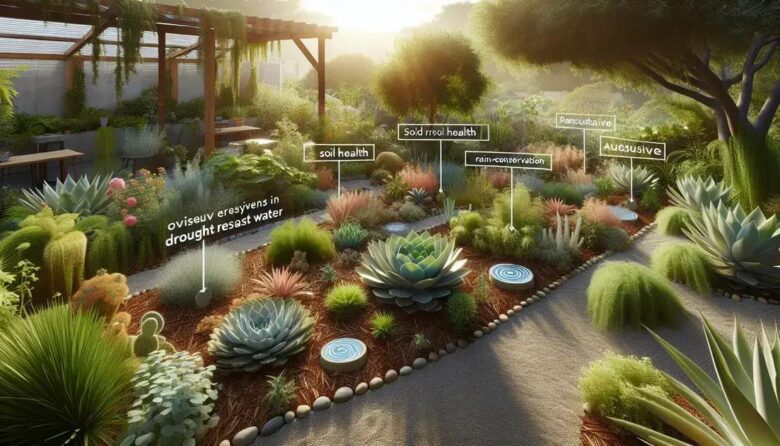Permaculture utilizes sustainable practices like drought-resistant plants, companion planting, and water conservation techniques to create resilient gardens that thrive with minimal resources in arid environments.
Permaculture offers ingenious solutions for those facing drought challenges in their planting endeavors. By adopting these sustainable strategies, you can manage water usage while still cultivating a thriving garden. Ever considered how these methods might transform your gardening approach? Let’s dig into some practical tips and strategies.
understanding permaculture: a brief overview
Permaculture is a holistic design approach that emphasizes sustainable agricultural practices, integrating natural ecosystems into productive environments. This method seeks to create a permanent culture by harmonizing human needs with nature’s abilities. It involves observing and understanding the land, climate, and local resources to develop self-sustaining systems.
Principles of Permaculture
Key principles include care for the earth, care for the people, and fair share of resources. These principles guide the planning and implementation of permaculture systems, promoting balance between consumption and regeneration.
Design Techniques
Permaculture designs often incorporate techniques like companion planting and natural pest management to enhance biodiversity and productivity. Layouts typically use zones for different activities, enabling efficient energy use and resource conservation.
Benefits of Permaculture
By adapting to the natural landscape and climate, permaculture offers resilience against environmental challenges such as droughts. This approach helps conserve water, enrich soil, and create ecosystems that sustain themselves over time.
Whether applied in urban gardens or rural farms, permaculture provides a framework for environmentally conscious living and farming, ensuring both immediate and long-term benefits for practitioners and their communities.
identifying drought-resistant plants for your garden
Selecting drought-resistant plants is crucial for creating a garden that thrives with minimal water. These plants are adapted to survive with less moisture, making them ideal for areas prone to dry spells. Consider native species first, as they are naturally suited to your local climate and soil conditions.
Top Drought-Tolerant Varieties
Succulents like aloe and sedum are excellent choices due to their water-storing capabilities. Additionally, herbs like rosemary and lavender not only add fragrance but also tolerate dry environments well. Ornamental grasses and certain perennials, such as yarrow and coneflower, can also withstand arid conditions.
Understanding Plant Needs
To ensure your garden flourishes, group plants with similar water requirements together. This method, known as hydrozoning, optimizes water usage by delivering it where it’s needed most. Moreover, mulching around plants helps retain soil moisture and reduce evaporation.
Seasonal Considerations
Keep in mind that even drought-resistant plants may need additional watering during the first growing season to establish their root systems. As they mature, their water needs decrease, allowing them to maintain vitality and beauty with little care.
By carefully selecting and arranging drought-resistant plants, you can create a sustainable and vibrant garden that conserves water resources while providing a lush and friendly habitat.
soil management techniques for arid environments
Effective soil management is essential for thriving in arid environments. The goal is to improve soil structure, increase moisture retention, and enhance fertility, which are vital for plant growth in dry conditions.
Mulching
One of the best practices is mulching, which involves covering the soil with organic materials like straw, leaves, or bark. This layer reduces evaporation, limits weed growth, and eventually breaks down to enrich the soil with nutrients.
Composting
Composting adds organic matter to the soil, which improves its ability to hold moisture. Regular use of compost increases microbial activity, enriching the soil with essential nutrients necessary for plant health.
Soil Amendments
Adding amendments like gypsum can help break up compacted soil, allowing roots to penetrate more deeply. This ensures that water can reach the root zone more efficiently, particularly during periods of low rainfall.
Swales
Integrating swales, which are shallow trenches, helps capture and retain rainwater. By directing the flow of water, swales allow it to seep slowly into the soil, minimizing runoff and erosion.
By adopting these techniques, you promote a healthy and vibrant garden that withstands the challenges of arid environments, ensuring longevity and sustainability.
integrated water conservation strategies
Implementing integrated water conservation strategies is key to maintaining a sustainable garden, especially in drought-prone areas. These methods focus on maximizing water efficiency and retaining moisture in the soil.
Drip Irrigation Systems
Drip irrigation provides water directly to the plant roots, minimizing evaporation and water wastage. Setting up a drip system can significantly reduce water use compared to traditional sprinklers.
Rainwater Harvesting
Collecting rainwater using barrels or tanks allows you to store and use this resource during dry periods. It’s an effective way to cut down on municipal water usage and ensure plants receive sufficient hydration.
Greywater Recycling
Reusing greywater from sinks, showers, and laundry can greatly extend your water supply. Properly treated, this water is safe for irrigating plants and contributes to a more sustainable household.
Sustainable Landscaping
Incorporating native plants and drought-tolerant species helps reduce dependency on supplemental watering. These plants are adapted to the local climate and can flourish with minimal irrigation.
Adopting these strategies not only conserves water but also promotes a healthy, resilient environment that can withstand challenging conditions.
companion planting for resilient ecosystems
Companion planting is a gardening strategy where different plants are grown together to enhance growth, protect against pests, and boost yield. This method creates a more resilient ecosystem by utilizing the natural benefits that plants provide each other.
Beneficial Plant Combinations
Some classic pairings include tomatoes with basil, which can repel insects and enhance flavor, and carrots with onions, where the strong scent of onions deters carrot flies. These combinations utilize natural plant properties to create a harmonious growing environment.
Pest Control
Certain plants can act as natural pesticides. Marigolds, for example, release chemicals into the soil that help deter nematodes, protecting vulnerable plants like tomatoes and peppers.
Nutrient Sharing
Legumes such as beans and peas can fix nitrogen in the soil, benefiting nutrient-hungry neighbors like corn. This relationship fertilizes the soil naturally, reducing reliance on synthetic fertilizers.
Space Optimization
Growing taller plants with lower groundcover varieties maximizes garden space. For instance, planting pole beans with squash allows each plant to take advantage of different vertical spaces.
By integrating companion planting techniques, gardeners can create self-sufficient and sustainable ecosystems in their gardens, enhancing plant health and reducing the need for chemical interventions.
monitoring and adjusting your permaculture setup
Regularly monitoring and adjusting your permaculture setup is vital for maintaining a healthy and productive garden. This process ensures that your system continues to thrive and adapt to changing conditions.
Observation Techniques
Spend time in your garden observing plant health, soil moisture, and weather patterns. Keeping a journal to document changes and challenges can help you make informed decisions about adjusting your setup.
Soil and Plant Health
Test soil quality periodically to check pH levels and nutrient availability. Adjust soil amendments and compost applications based on test results to maintain optimal growing conditions.
Water Management
Check irrigation systems for efficiency by ensuring drip lines or sprinklers are functioning properly. Adjust watering schedules according to seasonal rainfall and plant needs.
Pest and Disease Control
Regularly inspect plants for signs of pests and diseases. Implement natural pest control methods, like introducing beneficial insects or using organic sprays, to keep ecosystems balanced.
By consistently observing and fine-tuning your permaculture system, you can maximize the health and output of your garden, ensuring it remains sustainable and resilient over time.
Embracing Permaculture for a Sustainable Future
Permaculture offers a remarkable way to create sustainable, resilient gardens that thrive even in challenging conditions. By understanding its principles and applying strategies like selecting drought-resistant plants, improving soil management, and utilizing integrated water conservation techniques, you can optimize your natural environment.
Companion planting further enhances your garden’s ecosystem, ensuring robust growth and natural pest control. Monitoring and adjusting your setup keeps your garden in peak health and productivity.
Adapting to these practices not only benefits your immediate surroundings but also contributes to a broader ecological balance. As you continue to learn and refine your approach, you’ll find that permaculture is a rewarding journey toward sustainability and environmental harmony.
FAQ – Common Questions About Permaculture and Drought-Resistant Gardening
What is permaculture?
Permaculture is a sustainable design approach that harmonizes human activities with natural ecosystems. It focuses on creating self-sustaining environments.
How do I choose drought-resistant plants for my garden?
Opt for native species and plants known for their water-saving characteristics, like succulents and certain herbs, which thrive with minimal water.
Why is soil management important in arid environments?
Effective soil management improves moisture retention, enhances fertility, and supports plant growth, which is crucial for sustainability in dry conditions.
What are integrated water conservation strategies?
These strategies involve practices like drip irrigation, rainwater harvesting, and greywater recycling to maximize water use efficiency and support resilient gardens.
How does companion planting benefit my garden?
Companion planting helps improve plant health by attracting beneficial insects, repelling pests, and optimizing space, contributing to a more resilient ecosystem.
How can I keep my permaculture garden healthy?
Regularly monitor soil and plant health, adjust water management practices, and observe plants for any signs of pests or diseases to maintain a thriving garden.



